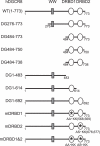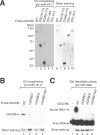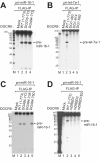Characterization of DGCR8/Pasha, the essential cofactor for Drosha in primary miRNA processing
- PMID: 16963499
- PMCID: PMC1636349
- DOI: 10.1093/nar/gkl458
Characterization of DGCR8/Pasha, the essential cofactor for Drosha in primary miRNA processing
Abstract
DGCR8/Pasha is an essential cofactor for Drosha, a nuclear RNase III that cleaves the local hairpin structures embedded in long primary microRNA transcripts (pri-miRNAs) in eukaryotes. Although our knowledge of pri-miRNA processing has significantly advanced in recent years, the precise role of DGCR8 in this pathway remains unclear. In our present study, we dissect the domains in DGCR8 that contribute to the processing of pri-miRNAs and the subcellular localization of DGCR8. Drosha is stabilized through an interaction between its middle domain and the conserved C-terminal domain of DGCR8. Furthermore, DGCR8, but not Drosha, can directly and stably interact with pri-miRNAs, and the tandem dsRNA-binding domains (dsRBDs) in DGCR8 are responsible for this recognition. Moreover, the DGCR8 N-terminal region upstream of its dsRBDs is unnecessary for pri-miRNA processing but is critical for nuclear localization. Our study thus provides further insights into the mechanism of action of the Drosha-DGCR8 complex in pri-miRNA processing.
Figures






Similar articles
-
Molecular basis for the recognition of primary microRNAs by the Drosha-DGCR8 complex.Cell. 2006 Jun 2;125(5):887-901. doi: 10.1016/j.cell.2006.03.043. Cell. 2006. PMID: 16751099
-
Crystal structure of human DGCR8 core.Nat Struct Mol Biol. 2007 Sep;14(9):847-53. doi: 10.1038/nsmb1294. Epub 2007 Aug 19. Nat Struct Mol Biol. 2007. PMID: 17704815
-
The Drosha-DGCR8 complex in primary microRNA processing.Genes Dev. 2004 Dec 15;18(24):3016-27. doi: 10.1101/gad.1262504. Epub 2004 Dec 1. Genes Dev. 2004. PMID: 15574589 Free PMC article.
-
MicroRNA biogenesis: isolation and characterization of the microprocessor complex.Methods Mol Biol. 2006;342:33-47. doi: 10.1385/1-59745-123-1:33. Methods Mol Biol. 2006. PMID: 16957365 Review.
-
Processing of virus-derived cytoplasmic primary-microRNAs.Wiley Interdiscip Rev RNA. 2013 Jul-Aug;4(4):463-71. doi: 10.1002/wrna.1169. Epub 2013 May 28. Wiley Interdiscip Rev RNA. 2013. PMID: 23776147 Review.
Cited by
-
Suppression of cancer stemness p21-regulating mRNA and microRNA signatures in recurrent ovarian cancer patient samples.J Ovarian Res. 2012 Jan 19;5(1):2. doi: 10.1186/1757-2215-5-2. J Ovarian Res. 2012. PMID: 22260314 Free PMC article.
-
Integration of expressed sequence tag data flanking predicted RNA secondary structures facilitates novel non-coding RNA discovery.PLoS One. 2011;6(6):e20561. doi: 10.1371/journal.pone.0020561. Epub 2011 Jun 15. PLoS One. 2011. PMID: 21698286 Free PMC article.
-
MicroRNAs with a nucleolar location.RNA. 2009 Sep;15(9):1705-15. doi: 10.1261/rna.1470409. Epub 2009 Jul 23. RNA. 2009. PMID: 19628621 Free PMC article.
-
A microRNA profile of human CD8(+) regulatory T cells and characterization of the effects of microRNAs on Treg cell-associated genes.J Transl Med. 2014 Aug 6;12:218. doi: 10.1186/s12967-014-0218-x. J Transl Med. 2014. PMID: 25090912 Free PMC article.
-
MicroRNA aberrations: An emerging field for gallbladder cancer management.World J Gastroenterol. 2016 Feb 7;22(5):1787-99. doi: 10.3748/wjg.v22.i5.1787. World J Gastroenterol. 2016. PMID: 26855538 Free PMC article. Review.
References
-
- Bartel D.P. MicroRNAs: genomics, biogenesis, mechanism, and function. Cell. 2004;116:281–297. - PubMed
-
- Kim V.N. Small RNAs: Classification, Biogenesis, and Function. Mol. Cells. 2005;19:1–15. - PubMed
-
- Lewis B.P., Burge C.B., Bartel D.P. Conserved seed pairing, often flanked by adenosines, indicates that thousands of human genes are microRNA targets. Cell. 2005;120:15–20. - PubMed
-
- Croce C.M., Calin G.A. miRNAs, cancer, and stem cell division. Cell. 2005;122:6–7. - PubMed
Publication types
MeSH terms
Substances
LinkOut - more resources
Full Text Sources
Molecular Biology Databases
Research Materials

